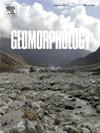Testing the hypogenic hypothesis for the origin of granite multi-concave topography using electrical resistivity tomography: A case study from the Southern Albera Massif (Pyrenees, Spain)
IF 3.1
2区 地球科学
Q2 GEOGRAPHY, PHYSICAL
引用次数: 0
Abstract
The pediment developed on the unweathered granite rocks of the South Albera Massif exhibits the characteristic morphology of an exhumed weathering front, where prominent residual landforms (tors and granite boulders) coexist with >240 weathering basins that shape a typical multi-concave topography. Active hydrothermalism is observed in the area, supporting the hypothesis that such weathering depressions may also be hypogenic in origin. Here we use Electrical Resistivity Tomography (ERT) to investigate the geo-electrical structure of the subsurface beneath four temporary ponds and associated depressions. The resistivity images reveal sub-vertical zones with resistivity low grades (150 and 450 Ohm·m) consistent with weathered granite, which spatially correlate with the shear zones identified at the surface. These weathered zones reach widths of approximately 100 m and extend vertically to depths beyond the effective ERT investigation depth (>170 m). The potential hypogenic origin of weathering depressions is supported by the following observations: (1) the occurrence of upwelling hydrothermal springs within one of the areas; (2) the widening of some weathered zones with depth; and (3) the preservation of unaltered rock masses overlaying altered zones. Spatial relationships between the studied depressions and the sub-vertical weathering structures are intricate. While some depressions entirely or partially overlap hypogenic alteration zones, in other cases, they fall outside the limits of these structures. This feature highlights the complexity of the weathering front evolution, where epigenic and hypogenic alteration processes coexist, driven by both structural factors and convergence of fluid flows of different nature.
利用电阻率层析成像技术验证花岗岩多凹地形成因假说:以西班牙比利牛斯山脉南部阿尔伯拉地块为例
在南阿尔伯拉地块未风化的花岗岩岩石上发育的山墙呈现出风化前沿的特征形态,其中突出的残余地貌(岩石和花岗岩巨石)与240个风化盆地共存,形成了典型的多凹地形。该地区存在活跃的热液作用,支持了这类风化洼地也可能是低成因的假设。在这里,我们使用电阻率层析成像(ERT)来研究四个临时池塘和相关洼地的地下地电结构。电阻率图像显示了与风化花岗岩一致的低电阻率等级(150和450欧姆·m)亚垂直带,其空间上与地表识别的剪切带相对应。这些风化带的宽度约为100米,垂直延伸至ERT有效探测深度(170米)以外的深度。以下观察结果支持了风化坳陷可能的低成因:①其中一个地区存在上升流热液泉;(2)部分风化带随深度变宽;(3)蚀变带上未蚀变岩体的保存。研究的坳陷与次垂向风化构造之间的空间关系错综复杂。有些凹陷完全或部分重叠于深部蚀变带,有些则不在这些构造的范围之内。这一特征凸显了风化锋演化的复杂性,在构造因素和不同性质流体汇聚的双重驱动下,形成了表生蚀变和下生蚀变并存的格局。
本文章由计算机程序翻译,如有差异,请以英文原文为准。
求助全文
约1分钟内获得全文
求助全文
来源期刊

Geomorphology
地学-地球科学综合
CiteScore
8.00
自引率
10.30%
发文量
309
审稿时长
3.4 months
期刊介绍:
Our journal''s scope includes geomorphic themes of: tectonics and regional structure; glacial processes and landforms; fluvial sequences, Quaternary environmental change and dating; fluvial processes and landforms; mass movement, slopes and periglacial processes; hillslopes and soil erosion; weathering, karst and soils; aeolian processes and landforms, coastal dunes and arid environments; coastal and marine processes, estuaries and lakes; modelling, theoretical and quantitative geomorphology; DEM, GIS and remote sensing methods and applications; hazards, applied and planetary geomorphology; and volcanics.
 求助内容:
求助内容: 应助结果提醒方式:
应助结果提醒方式:


